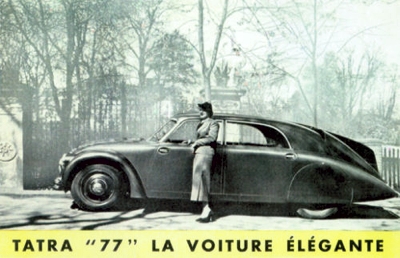The period before the World War 2 was the heyday of the streamlined motor car, most notably in Germany where Hitler's new motorways encouraged an awareness, in engineers and public alike, of the possibilities of sustaining very high speeds without cars squandering fuel to develop unnecessarily high power outputs.
Freiherr Konig von Fachsenfeld
The art of drag reduction and the science of
aerodynamics were pursued then with an enthusiasm never known before or since; but then, as later, most of the inspiration and genius came from two sources. One was Freiherr Konig von Fachsenfeld, a theoretician whose textbook remains as authoritative as his designs for Mercedes-Benz and others remain convincing, and who supplied the impetus for the work continued by Kamm, Everling, and others.
An even greater name was that of Paul Jaray - no less great a theoretician, artist, or practical engineer than any of the others, but far more successful in getting his designs actually built in substantial quantities.
Chief Designer of Zeppelin Airship Works
Jaray was born in 1889 in Vienna, and he moved to Prague to finish his technical education and start one of the first books about
aerodynamics. His ideas were very advanced, as may be judged from his instigation of the cantilever aircraft wing in 1910, a little ahead of Junkers. From then until 1923, he was principally concerned with aircraft, both heavier and lighter than air, and his most notable work was with the airship variety, and he became chief designer at the Zeppelin Airship Works.
It was the Zeppelin designers who took over from the ballisticians of the 19th century as the pacemakers of
aerodynamics. They had a particularly good wind tunnel to help them, run by the engineer Klemperer, and, with its aid, they established the ideal streamline shape, with its circular section, ogival nose, tapering tail, and a critical ratio of length to diameter-6:1, any deviation from which caused increased drag either through turbulence or skin friction.
It was hardly surprising that Jaray should have been competent to publish the first effective patents covering streamlined cars in 1921. What prompted him to take an interest in cars was the rudimentary 'raindrop' stream liner of Rumpler, but, whereas Rumpler's ideas were merely two-dimensional, Jaray, with Klemperer's help, devised a proper three-dimensional adaptation of the Zeppelin teardrop shape to the motor car. It was necessarily flattened underneath to match the road, but was well rounded on all other surfaces, the tail tapering to a horizontal edge, while the cabin superstructure (like half a teardrop) was blended in above it.
Building The Monoposto
In 1922, Jaray's prototypes proved on test to give a drag reduction approaching 25%. Then he built a monoposto racing car for Ley, increasing the I 60 mph maximum speed of the sports version to overSoon a mere 26 horsepower. Jaray's work was then interrupted by illness, which prompted him, after his recovery, to leave Zeppelins and make his home in Switzerland. There he began a programme of frantic design and development work, concentrating on combining drag reduction with unimpeachable road-going practicality-which included not only things like vision and access, but also the provision of outstandingly good ventilation and the elimination of any spurious
aerodynamic effects such as lift and directional instability.

Paul Jaray was instrumental in the design of the LZ 129 Hindenburg airship.

The Tatra 77 was the worlds first mass-produced streamilned car, built under license from Jaray.
|
All sorts of motor manufacturers were his customers, not only the expected German ones such as Adler, BMW, Maybach and Mercedes, but also foreigners such as Chrysler, Fiat and Tatra.
The 1927 Chrysler streamliner was based on work by Jaray, and, although its looks did not appeal to everybody, its 30% improvement in fuel economy was proof that Jaray's ideas worked. So was the Tatra 77 built in Czechoslovakia: for this uncommonly capacious six-seater to achieve 93 mph under the impulsion of only 65 horsepower was an outstanding achievement at a time when the latest and most exiguously bodied Le Mans racers needed 90 horsepower to reach the same speed.
As time went by, the lines of Jaray's bodies became more acceptable to the public. He was always constrained by the chassis of the time, which tended to be fashionably high and narrow, forcing his bodies to echo these proportions. Changing tastes brought cars and their occupants nearer to the ground, and Jaray took every opportunity to make his cars lower and sleeker.
Towards the end of the 1930s, Adler made some Jaray-styled lightweight saloons, which performed impressively at Le Mans and utterly convincingly on an Autobahn where one distinguished itself by covering more than 100 miles in one hour, driven by a little 1½-litre engine developing only 55 bhp.
By this time, Jaray had perfected his bodies to the point where their drag co-efficients ranged from 0.3 to as little as 0.19, when the typical touring car of the time had a co-efficient higher than 0.5. His own car from 1933 was built on Mercedes-Benz chassis with the body by Huber and Bruehwiler of Lucerne. Jaray was also interested in radio and television technology.
In 1941 he worked for Farner AG in Grenchen on nosewheel undercarriage design. In 1944 he set up as an independent engineer working on wind-driven power station. He was an author of large number of technical patents relating to
streamlining, air compressors for railway, devices for
handling gases in silencers. Later he lectured at Eidgenoessische Technische Hochschule (Swiss Federal Institute of Technology), Zurich.
Also see: Honour Roll - Founding Fathers Of The Automotive Industry



